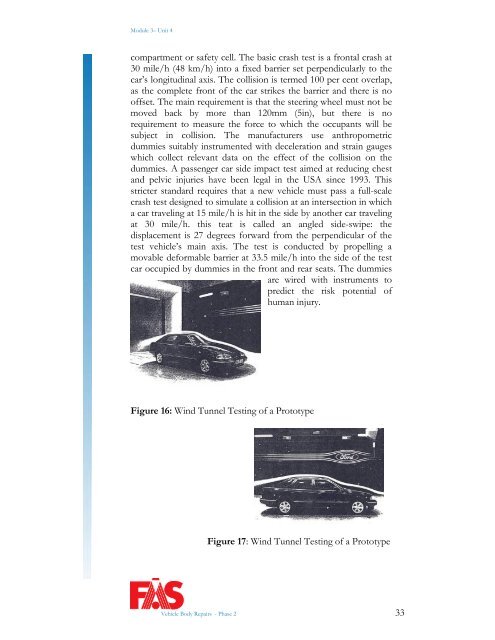TRADE OF VEHICLE BODY REPAIR - eCollege
TRADE OF VEHICLE BODY REPAIR - eCollege
TRADE OF VEHICLE BODY REPAIR - eCollege
Create successful ePaper yourself
Turn your PDF publications into a flip-book with our unique Google optimized e-Paper software.
Module 3– Unit 4<br />
compartment or safety cell. The basic crash test is a frontal crash at<br />
30 mile/h (48 km/h) into a fixed barrier set perpendicularly to the<br />
car’s longitudinal axis. The collision is termed 100 per cent overlap,<br />
as the complete front of the car strikes the barrier and there is no<br />
offset. The main requirement is that the steering wheel must not be<br />
moved back by more than 120mm (5in), but there is no<br />
requirement to measure the force to which the occupants will be<br />
subject in collision. The manufacturers use anthropometric<br />
dummies suitably instrumented with deceleration and strain gauges<br />
which collect relevant data on the effect of the collision on the<br />
dummies. A passenger car side impact test aimed at reducing chest<br />
and pelvic injuries have been legal in the USA since 1993. This<br />
stricter standard requires that a new vehicle must pass a full-scale<br />
crash test designed to simulate a collision at an intersection in which<br />
a car traveling at 15 mile/h is hit in the side by another car traveling<br />
at 30 mile/h. this teat is called an angled side-swipe: the<br />
displacement is 27 degrees forward from the perpendicular of the<br />
test vehicle’s main axis. The test is conducted by propelling a<br />
movable deformable barrier at 33.5 mile/h into the side of the test<br />
car occupied by dummies in the front and rear seats. The dummies<br />
are wired with instruments to<br />
predict the risk potential of<br />
human injury.<br />
Figure 16: Wind Tunnel Testing of a Prototype<br />
Figure 17: Wind Tunnel Testing of a Prototype<br />
Vehicle Body Repairs - Phase 2 33
















